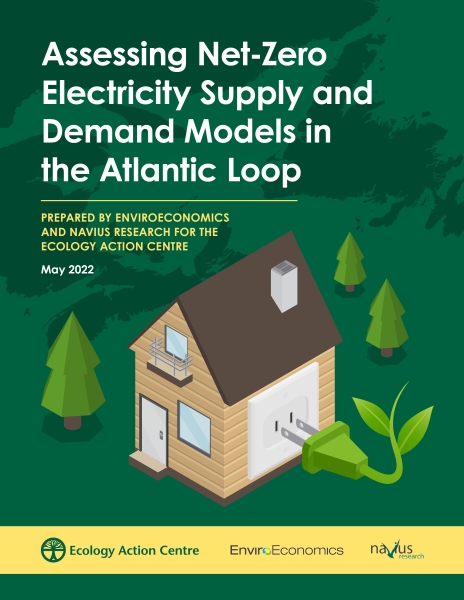Estimates indicate that Nova Scotia will more than double electricity generation by 2050. The heating and cooling of buildings, increased use of data stored in the “cloud”, and growing interest in electric vehicles are just a few examples of why demand will rise. This awareness compels the Ecology Action Centre (EAC) to explore options for clean, reliable and affordable energy. We must prevent further damage to our shared environment.
Fortunately, opportunities exist that point the way toward a more energy efficient future.
Coal Phase-Out
Coal Phase-Out
Our 2019 report Accelerating the Coal Phase Out: Nova Scotia and the Climate Emergency charts the path for a low-carbon electricity system in Nova Scotia. It proposes a scenario that leads to 90 per cent renewable electricity, a complete phase-out of coal power, and significant increases in energy efficiency and electric transportation – all by the year 2030. This report is the first of its kind in Atlantic Canada and demonstrates that phasing out coal in Nova Scotia is possible, timely, and necessary.
Highlights:
-
This report is an extensive technical and modelling exercise for what an electricity grid with more than 90 per cent renewable electricity, and a complete transition away from coal-fired electricity generation by 2030 would look like in Nova Scotia.
-
The proposed pathway would lead to significant overall greenhouse gas emissions reductions - more than 69 per cent below 2005 levels by 2030 or a provincial total of about 7.3 million tonnes.
- Key measures and results from the low-carbon pathway in the report include:
- Substantial increases in energy efficiency programming by the year 2030 such as: 80 per cent of residential and commercial buildings receive deep-energy retrofits; major shifts to heat pumps for space heating and hot water; shifts away from oil and natural gas heating; and efficiency gains in lighting and other appliances.
- A doubling of wind power, with the addition of 600 to 800 MW.
- Significantly increasing solar power, with the addition of about 480 MW.
- Building a second transmission link to New Brunswick, and importing about 200MW of existing hydroelectricity capacity from Quebec.
We commissioned Torrie Smith Associates to author this report. Click here to read the report summary.
Did you know?
The Federal government’s analysis has shown that phasing out coal electricity in Nova Scotia by 2030 would avoid 89 premature deaths, 8,000 asthma episodes, and 58,000 days of breathing difficulty for Nova Scotians, among other benefits. Unfortunately, coal-fired electricity remains our province’s single largest electricity generation source. It’s also our largest single source of greenhouse gas emissions. Continuing to reduce our dependence on coal and transitioning to a fossil-free electricity system are the keys to positive change.
Renewable Energy, Trade & Interregional Transmission Planning
Holistic Network Design for Offshore Wind & Interregional Planning
Interested in learning more about how increasing trade of energy between provinces can support our renewable energy transition and decarbonization efforts? Check out our webinar from Oct. 12, 2022, where we expand thinking beyond the Atlantic Loop, explore possibilities for incorporating offshore wind into the energy mix in Eastern Canada and consider how holistic network design could help build an electricity system in Atlantic Canada which balances economic, reliability, environmental and community impacts and considerations. Watch the webinar below or read the summary for policy makers here.
Atlantic Loop
To assist in highlighting clean electricity supply scenarios and demonstrating possible pathways to decarbonize the Atlantic region by 2050, the EAC commissioned EnviroEconomics and Navius Research to author a technical and modelling report. That report entitled, Assessing Net-zero Electricity Supply and Demand Models in the Atlantic Loop, was released in May 2022.
This report models various net-zero and Atlantic Loop scenarios. It also demonstrates a rapid decline in emissions for both Nova Scotia and New Brunswick in the net-zero simulations, which is attributed to the coal phase-out targets.
Watch a panel discussion on our Atlantic Loop report below.
We've highlighted and discussed various clean electricity supply scenarios to decarbonize Atlantic Canada by 2050. The report is a part of our Atlantic Vision for a future where electricity is affordable, reliable and sustainable.
Speakers:
- Gurprasad Gurumurthy, Ecology Action Centre
- Dave Sawyer, EnviroEconomics
Offshore Wind
Offshore Wind
In dealing with the climate crisis, Nova Scotia needs to develop untapped renewable energy resources. These resources play a part in decarbonizing our provincial energy system, mostly by phasing out coal and fossil fuels.
Offshore wind is another energy source that could support our provincial climate goals. However, challenges arise from this new industry, mainly related to the environmental impacts from their development. From the EAC’s perspective, offshore wind power must be delivered to the grid like other renewable energy sources, but a comprehensive environmental and social analysis must also be established.
Read the EAC's position statement on offshore wind.
Comparative jurisdictional research
The federal and provincial governments have agreed on the terms of reference for a Regional Assessment of Offshore Wind Development in Nova Scotia that will provide information, knowledge and analysis regarding future offshore wind development activities and their potential effects. The committee for this assessment was appointed in March 2023, and they will do the assessment work over the next 18 months. To contribute to the current discussion on offshore wind, the EAC commissioned East Coast Environmental Law (ECEL) to complete a comparative jurisdictional research report that explores how offshore wind is assessed and regulated in Germany, the United Kingdom of Great Britain and Northern Ireland and the United States.
Read the complete report from ECEL here, or read the report summary here.
The report focuses on whether and how the rules of comparative jurisdictions were intended to evaluate the sustainability of proposed offshore wind projects; and incorporate cumulative effects assessment into planning, assessment and permitting processes. It also offers suggested best practices for offshore wind development that could be beneficial for Nova Scotia.
Overcoming Legislative Barriers
Overcoming Legislative Barriers
To transform our coal-dependent electricity regime, Nova Scotia must evolve from old, outdated legislation.
We are more informed and better prepared to prioritize clean, affordable, and reliable electricity now than ever before. This starts with a legislated sustainability mandate that gives clear prioritization of environmental and social outcomes to the Nova Scotia Utility and Review Board (NSUARB) using a three-pronged approach:
-
Create a standalone mandate provision which includes a sustainability mandate.
-
Establish a legislated statement of provincial electricity policy which incorporates sustainability considerations.
-
Legislate a list of relevant sustainability principles which illustrates how the sustainability mandate should be interpreted.
Other jurisdictions have moved in this direction, and it is time Nova Scotia followed. Learn more in our sustainability mandate overview here. We advocate further for this sustainability mandate in our submission to Nova Scotia's Clean Electricity Solutions Task Force in October 2023.
In this 2021 report from East Coast Environmental Law, read about whether sustainability mandates in Canadian and New England jurisdictions offer useful models for the NSUARB. The report also analyzes key legislative language and proposes amendments to the Public Utilities Act or Electricity Act or corresponding regulations and explains how those amendments would further the EAC’s goals for electricity reform in Nova Scotia.
Renewable Energy
Renewable Energy
Transitioning from fossil fuel–powered electricity to clean, renewable sources is the foundation for many policies needed to effectively address the climate crisis. The Ecology Action Centre commissioned Torrie Smith Associates to author a technical and modelling report as to what an electricity grid with more than 90 per cent renewable electricity, and a complete transition away from coal-fired electricity generation by 2030, would look like in Nova Scotia.
This report - Accelerating the Coal Phase Out: Nova Scotia and the Climate Emergency – proposes a solid path forward for coal phase-out, with numerous options including:
- A generation mix of about 43 per cent wind, 5 per cent solar, 43 per cent hydro and 9 per cent natural gas by 2030.
- A doubling of wind power in Nova Scotia, with the addition of 600 to 800 MW.
- Significantly increasing solar power in Nova Scotia, with the addition of about 480 MW.
- Building a second transmission link to New Brunswick and importing about 200MW of existing hydroelectricity capacity from Quebec.
Shifting to 100 per cent renewable electricity is possible. It’s also better for our health, the environment and affordability. With our electricity sector poised to double by 2030, a change from coal, one of the most polluting forms of energy worldwide, is critical to meeting our climate targets.
Energy Demystifiers
Energy Demystifiers
As Nova Scotia’s electricity demands increase, our need to transition to renewable energy becomes more urgent. But how much do we really know about our electricity systems and our power as citizens to shape them? It’s important for us all to know how to affect change in our systems to help move our province toward clean, reliable and affordable energy. This transition is possible, and it has the power to make our lives better now and for future generations.
When you know the system, you can advocate for a better one. It's in our power. Read our Energy System Demystifier, Renewables Demystifier and Atlantic Loop Demystifier to learn how these systems work so you can help us strive for a better energy future for all Nova Scotians. Be informed, get involved and help our province move toward a clean energy future!
Clean Electricity Regulation FAQ
Clean Electricity Regulation FAQ
In August 2023, the federal government released the first draft of the long-awaited Clean Electricity Regulation (CER), which sets out a suit of regulations aimed at helping Canada achieve a net-zero electricity grid by 2035. We've put together a short fact sheet on the CER to help you better understand the regulations and engage with your elected officials. Check it out below!


